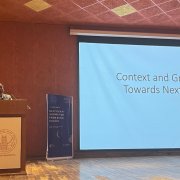February 21, 2023 - 9:30 am
By unlocking the secrets of anesthesia, Professor Emery Brown could help shed light on brain diseases, hibernation, and possibly even human consciousness.
By Adam Piore
Last spring, Brown stepped down after 10 years as co-director of the Harvard-MIT Program in Health Sciences and Technology (HST), which trains clinician-scientists and engineers, to focus on creating a new joint research center between MIT and MGH. The center will use anesthesia...
February 14, 2023 - 4:00 pm
McGovern Reading Room (46-5165)
Akhilan Boopathy, MIT graduate student in the Fiete Lab
Abstract: The measure of a machine learning algorithm is the difficulty of the tasks it can perform, and sufficiently difficult tasks are critical drivers of strong machine learning models. However, quantifying the generalization difficulty of machine learning benchmarks has remained challenging....
February 7, 2023 - 4:00 pm
Singleton Auditorium (46-3002)
Leyla Isik, Johns Hopkins University
Leyla Isik is the Clare Boothe Luce Assistant Professor in the Department of Cognitive Science at Johns Hopkins University. Her research aims to answer the question of how humans extract complex information using a combination of human neuroimaging, intracranial recordings, machine learning, and...
February 6, 2023 - 2:45 pm
[translated by Google Translate]
With Alphafold, Deepmind revolutionized chemistry. The company is now working on competing with Chat-GPT, says the founder in an interview.
by Ruth Fulterer
If you wanted to nominate a polymath today, Demis Hassabis would be on the list of candidates. The 47-year-old is a candidate for the Nobel Prize in Chemistry thanks to his AI Alphafold, which predicts protein folding. And by then he had already had three...
February 1, 2023 - 2:45 pm
ChatGPT is in the spotlight, but it’s Whisper—OpenAI’s open-source speech-transcription program—that shows us where machine learning is going.
By James Somers
One day in late December, I downloaded a program called Whisper.cpp onto my laptop, hoping to use it to transcribe an interview I’d done. I fed it an audio file and, every few seconds, it produced one or two lines of eerily accurate transcript, writing down exactly what had been said with...
January 30, 2023 - 10:45 am
Indian Institute of Technology Jodhpur conducted NAiBS-2023 international conference from 26th to 28th January 2023. The conference aimed at bringing together researchers across domains for discussions on the common goal of designing AGI (Artificial General Intelligence) systems – drawing inspiration from individual sensorimotor computations leading to multimodal processes in the human brain. The conference also envisioned being of interest to a...
January 12, 2023 - 4:30 pm
Demis Hassabis stands halfway up a spiral staircase, surveying the cathedral he built. Behind him, light glints off the rungs of a golden helix rising up through the staircase’s airy well. The DNA sculpture, spanning three floors, is the centerpiece of DeepMind’s recently opened London headquarters. It’s an artistic representation of the code embedded in the nucleus of nearly every cell in the human body. “Although we work on making machines...
December 6, 2022 - 4:00 pm
McGovern Seminar Room (46-3189)
Diego Mendoza-Halliday, Research Scientist, McGovern Institute for Brain Research at MIT
In person and open to the MIT Community.
Abstract:
Visual attention and working memory are two different cognitive functions. However, because of their close relationship and interactions, it is often claimed that they share the same underlying neuronal mechanisms. Here, I will first describe...
Abstract:
Visual attention and working memory are two different cognitive functions. However, because of their close relationship and interactions, it is often claimed that they share the same underlying neuronal mechanisms. Here, I will first describe...
November 22, 2022 - 4:00 pm
Virtual
Margaret Livingstone, Harvard Medical School
Margaret Livingstone is the Takeda Professor of Neurobiology in the Blavatnik Institute of Neurobiology at Harvard Medical School. Livingstone has long been interested in how tuning properties of individual neurons can be clustered at a gross level in the brain. The lab began by looking at the...
November 17, 2022 - 12:30 pm
Society for Neuroscience honors BCS professor for breakthrough research modeling a component of the brain’s navigational system.
The Society for Neuroscience (SfN) has awarded the Swartz Prize for Theoretical and Computational Neuroscience to Ila Fiete, professor in the Department of Brain and Cognitive Sciences, associate member of the McGovern Institute for Brain Research, and director of the K. Lisa Yang Integrative Computational Neuroscience...
November 8, 2022 - 4:00 pm
Singleton Auditorium (46-3002)
Prof. Winrich Freiwald, The Rockefeller University
Current understanding of the neural mechanisms of face processing, and the computational principles they employ, is based, primarily, on studies of a set of fMRI-identified face areas inside macaque inferotemporal cortex. These face areas contain very high fractions of face cells, occur at...
November 4, 2022 - 8:30 am
Singleton Auditorium (46-3002)
James DiCarlo, Tomaso Poggio, Joshua Tenenbaum, Nancy Kanwisher, Leslie Kaelbling, Ila Fiete, Evelina...
[recordings - on the right - are in reverse chronological order]
MIT's Quest for Intelligence aims to understand intelligence by tightly coupling scientific enquiry and rigorous engineering to address real-world problems that are beyond current machine capabilities but within the ability of natural...
MIT's Quest for Intelligence aims to understand intelligence by tightly coupling scientific enquiry and rigorous engineering to address real-world problems that are beyond current machine capabilities but within the ability of natural...
November 1, 2022 - 12:45 pm
This machine-learning system can simulate how a listener would hear a sound from any point in a room.
Adam Zewe | MIT News Office
Imagine the booming chords from a pipe organ echoing through the cavernous sanctuary of a massive, stone cathedral.
The sound a cathedral-goer will hear is affected by many factors, including the location of the organ, where the listener is standing, whether any columns, pews, or other obstacles stand between them,...
October 18, 2022 - 4:15 pm
PhD candidate Raúl Mojica Soto-Albors seeks to understand the rules of plasticity that underlie neuronal behavior.
Olivia Young | Office of Graduate Education
When he matriculated in 2019 as a graduate student, Raúl Mojica Soto-Albors was no stranger to MIT. He’d spent time here on multiple occasions as an undergraduate at the University of Puerto Rico at Mayagüez, including eight months in 2018 as a displaced student after Hurricane Maria in...
October 18, 2022 - 4:00 pm
Singleton Auditorium (46-3002)
Prof. George Konidaris, Brown University
Abstract: AI is, at once, an immensely successful field---generating remarkable ongoing innovation that powers whole industries---and a complete failure. Despite more than 50 years of study, the field has never settled on a widely accepted, or even well-formulated, definition of its...














